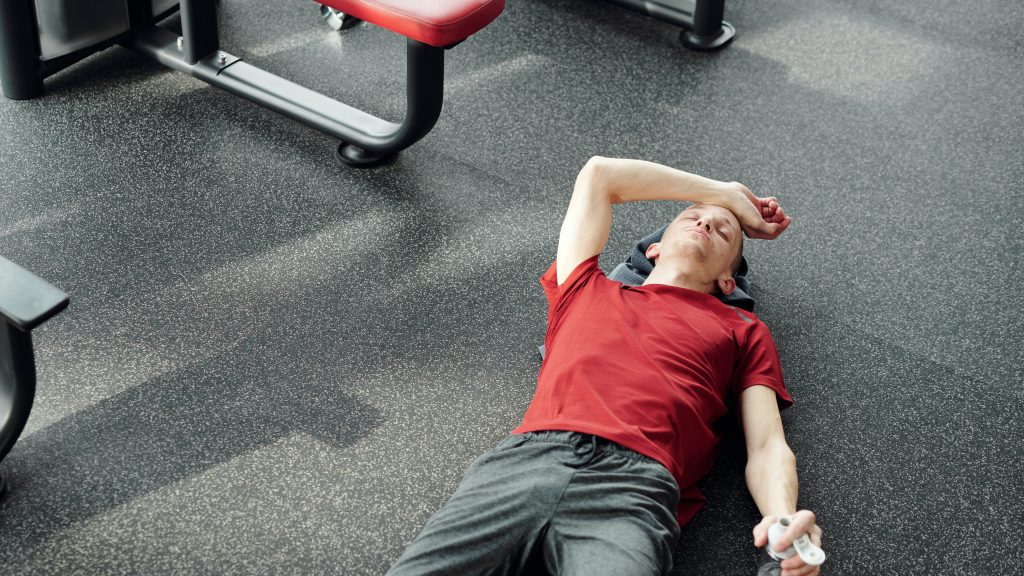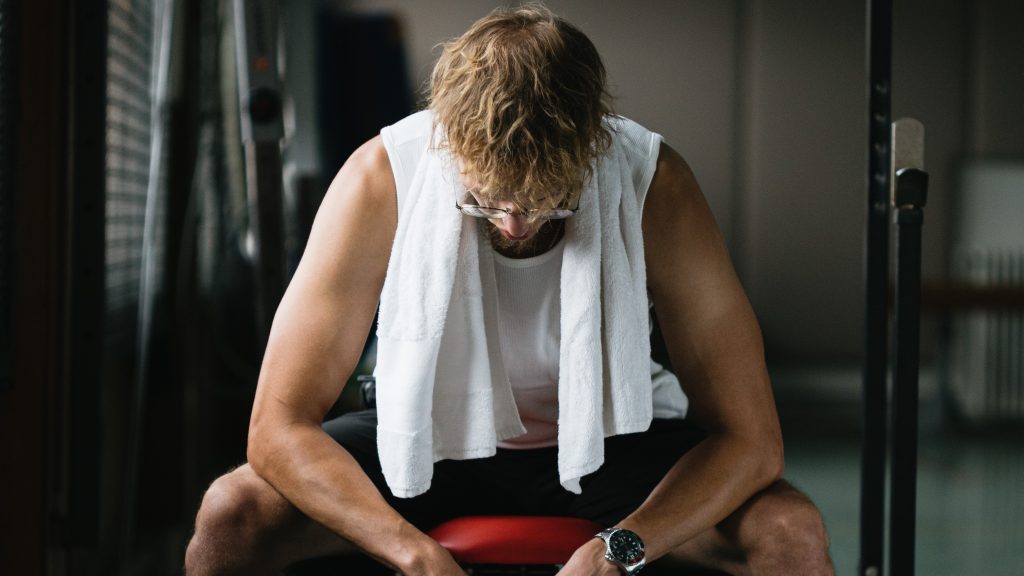Introduction:
Resting between intense workouts is often overlooked, as many fitness enthusiasts believe that constant training is the key to achieving their goals. However, understanding the importance of rest and recovery is essential for optimal fitness results. In this article “Strike the Perfect Balance: The Advantages of Resting Between Intense Workouts”, we will delve into the advantages of resting between intense workouts and explore why it is crucial for maximizing performance, preventing injuries, and achieving long-term fitness goals.
-
Understanding the concept of muscle recovery:
a. Resting allows muscles to repair and rebuild: During intense workouts, muscle fibers undergo microscopic damage. Resting periods provide the necessary time for the body to repair and rebuild these muscle fibers, leading to muscle growth and strength gains.
b. Enhancing protein synthesis: Adequate rest promotes protein synthesis, the process where the body repairs and replaces damaged proteins in muscle tissues, ensuring their optimal function and growth.
-
Maximizing performance:
a. Restoration of energy stores: Intense workouts deplete energy stores such as glycogen. Resting between workouts allows these stores to replenish, ensuring optimal energy levels for subsequent training sessions.
b. Recovery of the nervous system: Intense workouts place a significant demand on the nervous system. Rest periods help restore the nervous system, improving coordination, reaction time, and overall performance.
-
Injury prevention:
a. Reducing the risk of overuse injuries: Continuous training without proper rest increases the risk of overuse injuries such as stress fractures, tendinitis, and muscle strains. Resting between workouts allows the body to recover and adapt, reducing the likelihood of these injuries.
b. Allowing time for minor injuries to heal: Rest periods provide an opportunity for minor injuries or nagging pain to heal. Ignoring these issues and pushing through intense workouts can exacerbate the injuries and lead to more severe problems.
-
Hormonal balance and immune system support:
a. Managing cortisol levels: Intense exercise can elevate cortisol levels, a stress hormone associated with muscle breakdown and fat storage. Resting between workouts helps maintain a healthy hormonal balance, reducing the negative impact of cortisol on the body.
b. Strengthening the immune system: Overtraining can suppress the immune system, making individuals more susceptible to illnesses. Adequate rest and recovery support the immune system, allowing it to function optimally.
-
Mental and emotional well-being:
a. Avoiding burnout and mental fatigue: Constantly pushing oneself without rest can lead to burnout and mental fatigue. Rest periods provide time for relaxation and rejuvenation, helping to maintain motivation and mental clarity.
b. Enhancing sleep quality: Resting between intense workouts allows for better sleep quality, which is crucial for muscle recovery, cognitive function, and overall well-being.
-
Individualization and periodization:
a. Tailoring rest periods to individual needs: Rest requirements may vary depending on factors such as fitness level, age, and training intensity. It’s important to listen to your body and adjust rest periods accordingly. Some individuals may require longer or more frequent rest periods to recover adequately.
b. Implementing periodization in training: Periodization involves planned variations in training intensity and volume, including rest periods. Structuring workouts with periods of high intensity followed by rest and recovery can optimize performance and prevent plateaus.
-
Cross-training and active recovery:
a. Engaging in cross-training activities: Rest days can be an opportunity to engage in low-impact activities such as swimming, cycling, or yoga, which promote active recovery while allowing specific muscle groups used in intense workouts to rest.
b. Incorporating active recovery exercises: Light exercises like stretching, foam rolling, or mobility drills can enhance blood flow to the muscles, reduce muscle soreness, and accelerate the recovery process.
-
Monitoring progress and listening to the body:
a. Tracking performance and fatigue levels: Regularly monitoring performance metrics and assessing fatigue levels can help determine the effectiveness of rest periods and ensure appropriate recovery.
b. Paying attention to signs of overtraining: Symptoms like persistent muscle soreness, decreased performance, chronic fatigue, irritability, and disrupted sleep patterns may indicate overtraining. If these signs arise, it’s crucial to incorporate additional rest or seek professional advice.
-
Nutrition and hydration during rest periods:
a. Adequate nutrition for recovery: Consuming a balanced diet with sufficient protein, carbohydrates, and healthy fats during rest periods provides the necessary nutrients for muscle repair, glycogen replenishment, and overall recovery.
b. Staying hydrated: Proper hydration is vital for muscle function, joint lubrication, and overall well-being. Drink adequate amounts of water throughout the day, especially during rest periods.
-
Gradual progression and long-term sustainability:
a. Avoiding the “more is better” mentality: Quality over quantity is essential in training. Gradually increasing training intensity and volume while incorporating adequate rest periods promotes long-term progress and helps prevent injuries.
b. Prioritizing long-term sustainability: Balancing intense workouts with rest allows individuals to sustain their fitness journey in the long run. Overtraining can lead to setbacks, injuries, and burnout, hindering progress.
-
Strategies for optimizing rest periods:
a. Active rest: Instead of complete inactivity, incorporate light activities during rest periods to promote blood flow, relaxation, and recovery. Examples include walking, gentle yoga, or foam rolling.
b. Sleep hygiene: Prioritize quality sleep by establishing a consistent sleep schedule, creating a relaxing bedtime routine, and ensuring a comfortable sleep environment. Aim for 7-9 hours of uninterrupted sleep each night.
c. Stress management techniques: Integrate stress-reducing practices such as meditation, deep breathing exercises, or mindfulness to enhance the effectiveness of rest periods and support overall well-being.
d. Massage therapy or self-massage: Consider incorporating regular massages or self-massage techniques like using foam rollers or massage balls to alleviate muscle tension, enhance circulation, and expedite recovery.
-
Long-term benefits of incorporating rest:
a. Injury prevention and longevity: By allowing the body to recover and repair, adequate rest decreases the risk of overuse injuries and promotes a healthy, resilient physique over time.
b. Plateau avoidance and continued progress: Rest periods help prevent training plateaus by allowing the body to adapt and recover, leading to consistent gains in strength, endurance, and performance.
c. Enhanced overall well-being: Balancing intense workouts with rest fosters a healthier relationship with exercise, reducing stress and promoting mental well-being.
d. Improved body composition: Proper rest and recovery optimize hormonal balance, promoting muscle growth and fat loss, leading to improved body composition.

Photo by Andres Ayrton: https://www.pexels.com/photo/ethnic-woman-with-towel-exercising-in-gym-6550869/
-
Incorporating mobility and flexibility work:
a. Stretching exercises: During rest periods, allocate time for gentle stretching to improve flexibility, maintain joint range of motion, and alleviate muscle tightness.
b. Mobility drills: Engage in mobility exercises that target specific joints and muscle groups to enhance mobility and movement efficiency, reducing the risk of injuries during intense workouts.
-
Utilizing recovery tools and techniques:
a. Cold therapy: Alternating between hot and cold showers or using ice baths can help reduce inflammation, muscle soreness, and promote faster recovery.
b. Compression therapy: Compression garments or compression sleeves can aid in improving blood circulation, reducing muscle swelling, and accelerating recovery.
c. Epsom salt baths: Soaking in a warm bath with Epsom salt can help relax muscles, reduce muscle soreness, and promote relaxation.
-
Periodic deloading weeks:
a. Deloading weeks involve reducing training volume or intensity periodically to allow for extended rest and recovery.
b. Deloading weeks can be implemented every 4-8 weeks, depending on individual needs and training intensity, to prevent overtraining and promote overall recovery.
-
Seeking professional guidance:
a. Consulting with a certified fitness professional or coach can provide personalized advice on structuring training programs, incorporating rest periods, and optimizing recovery strategies.
b. Working with a healthcare professional or sports therapist can offer guidance on injury prevention, rehabilitation, and optimal rest and recovery practices.
-
Consistency and long-term mindset:
a. Emphasize the importance of consistency in balancing intense workouts and rest periods to achieve sustainable progress and long-term fitness goals.
b. Adopt a long-term mindset that prioritizes overall health, well-being, and enjoyment of the fitness journey rather than solely focusing on short-term results.
-
Tracking and adjusting:
a. Keep a training journal or utilize fitness apps to track workout intensity, volume, and rest periods. This allows for data-driven adjustments to optimize training and recovery.
b. Regularly evaluate and adjust rest periods based on individual needs, training progress, and feedback from the body.
-
Active lifestyle outside of workouts:
a. Stay active throughout the day by incorporating activities like walking, taking the stairs, or participating in recreational sports. This promotes overall fitness and enhances recovery by increasing blood flow and reducing muscle stiffness.
-
Hydration and nutrition during workouts and rest:
a. Stay hydrated before, during, and after workouts to support optimal performance and recovery. Drink water regularly and consider incorporating electrolyte-rich beverages for intense workouts.
b. Consume a balanced diet that includes lean proteins, whole grains, fruits, vegetables, and healthy fats. Proper nutrition fuels your body’s recovery process and supports muscle growth.
-
Mind-body practices:
a. Explore mind-body practices like yoga, tai chi, or meditation to enhance mindfulness, reduce stress, and improve overall well-being. These practices can complement intense workouts and promote relaxation during rest periods.
-
Peer support and accountability:
a. Engage with a workout buddy or join a fitness community to foster accountability, motivation, and support. Sharing experiences and challenges with like-minded individuals can enhance your commitment to balancing workouts and rest.
-
Learning from setbacks:
a. Understand that setbacks are a natural part of the fitness journey. If an injury or illness occurs, use it as an opportunity to learn, adapt, and prioritize rest and recovery to come back stronger.
-
Gradual progression in workouts:
a. Gradually increase the intensity, duration, or frequency of workouts over time to challenge your body without overwhelming it. This progressive approach allows for adequate adaptation and recovery.
-
Personalized rest and recovery strategies:
a. Experiment with different rest and recovery techniques to find what works best for your body. Listen to your body’s signals, adjust rest periods as needed, and prioritize self-care to optimize your recovery.
a. Practice deep breathing exercises during rest periods to promote relaxation, reduce stress, and enhance recovery. Deep diaphragmatic breathing can help activate the parasympathetic nervous system, inducing a state of calmness and aiding in the recovery process.
-
Periodic reassessment of goals:
a. Regularly reassess your fitness goals and make adjustments as needed. This includes evaluating the balance between intense workouts and rest periods to ensure they align with your evolving objectives and priorities.
-
Cross-training for variety:
a. Incorporate different types of exercises and activities into your routine to prevent boredom, engage different muscle groups, and allow for recovery in specific areas while still maintaining overall fitness levels.

Photo by Annushka Ahuja: https://www.pexels.com/photo/exhausted-young-female-boxer-leaning-on-punching-bag-after-workout-7991664/
-
Mental recovery techniques:
a. Engage in activities that promote mental relaxation and recovery, such as reading, listening to music, spending time in nature, or engaging in hobbies that bring you joy and help take your mind off training.
-
Social support and motivation:
a. Surround yourself with a supportive network of friends, family, or training partners who share similar fitness goals. Their encouragement and camaraderie can provide motivation and help you stay on track with your rest and recovery practices.
-
Periodic breaks and deload weeks:
a. Plan occasional extended breaks from intense training to give your body and mind a chance to fully recover, rejuvenate, and prevent burnout. Deload weeks with reduced training volume can also be scheduled periodically to allow for additional recovery.
-
Reflect and learn from your body’s signals:
a. Pay attention to your body’s cues and signals, such as fatigue, soreness, or decreased performance. Learn to differentiate between the need for rest and the need for pushing yourself, allowing for smarter and more intuitive training decisions.
-
Celebrate small victories and progress:
a. Acknowledge and celebrate the small milestones and progress you make along your fitness journey. Recognizing and appreciating your achievements can boost motivation, enhance mental well-being, and create a positive mindset towards rest and recovery.
-
Embrace a holistic approach to wellness:
a. Recognize that rest and recovery are not only essential for physical fitness but also for mental, emotional, and spiritual well-being. Embrace a holistic approach that considers all aspects of your health to achieve optimal balance and overall wellness.
-
Enjoy the process:
a. Embrace the joy and fulfillment that comes from taking care of your body and prioritizing rest. Emphasize the journey itself, finding pleasure in both the challenging workouts and the valuable rest periods that support your progress.
-
Utilizing technology for recovery tracking:
a. Explore smartphone apps or wearable devices that can track and analyze recovery metrics such as heart rate variability, sleep patterns, and overall readiness for intense workouts. These tools can provide valuable insights and help optimize rest periods.
-
Prioritizing mental and emotional rest:
a. Incorporate activities that promote mental and emotional well-being, such as mindfulness meditation, journaling, or engaging in hobbies that bring you joy. Taking time to recharge mentally and emotionally is crucial for overall recovery and balance.
-
Adjusting rest periods based on lifestyle factors:
a. Consider the demands of your daily life, such as work, family commitments, or other stressors, when planning rest periods. If you have a particularly busy week, adjust your training schedule to allow for more rest and recovery.
-
Active recovery strategies for specific muscle groups:
a. Identify muscle groups that may require additional attention and implement specific active recovery strategies for those areas. This may include targeted stretching, foam rolling, or using massage tools to alleviate tension and promote faster recovery.
-
Implementing strategic rest days within the training week:
a. Strategically plan rest days within your training week to ensure adequate recovery between intense workouts. This can help prevent cumulative fatigue and optimize performance during subsequent training sessions.

Photo by Julia Larson : https://www.pexels.com/photo/strong-black-man-wiping-forehead-with-towel-in-gym-6455950/
-
Mindfulness during workouts and rest periods:
a. Practice being present and fully engaged in your workouts, as well as during rest periods. Cultivate mindfulness by focusing on your breath, body sensations, and the present moment, which can enhance the effectiveness of both your training and recovery.
-
Supplementing with recovery aids:
a. Explore the use of recovery aids such as protein shakes, branched-chain amino acids (BCAAs), or natural anti-inflammatory supplements like turmeric. Consult with a healthcare professional or nutritionist to determine if these supplements are suitable for you.
-
Utilizing heat therapy for recovery:
a. Incorporate heat therapy techniques, such as using heat packs, warm baths, or sauna sessions, to promote muscle relaxation, improve blood circulation, and aid in recovery.
-
Periodic body composition assessments:
a. Conduct body composition assessments, such as measuring body fat percentage or tracking muscle mass, to evaluate the effectiveness of your rest and recovery strategies. This information can guide adjustments to your routine and help monitor progress.
-
Prioritizing quality sleep:
a. Create a sleep-friendly environment by ensuring a comfortable mattress, reducing exposure to electronic devices before bed, and establishing a consistent sleep routine. Quality sleep is vital for optimal recovery and overall well-being.
-
Seeking professional recovery services:
a. Explore affordable recovery services offered in your community, such as discounted sports massages or physical therapy clinics. These services can provide targeted recovery support and guidance within your budget.
-
Practicing self-care rituals:
a. Develop self-care rituals that align with your preferences and budget, such as taking relaxing baths, using aromatherapy, or engaging in gentle self-massage techniques. These rituals can help promote relaxation and enhance your overall well-being.
-
Experimenting with different rest durations:
a. Pay attention to how your body responds to different rest durations. Some individuals may benefit from shorter, more frequent rest periods, while others may require longer periods for optimal recovery. Experimentation will help you find the ideal rest duration for your needs.
-
Using progressive relaxation techniques:
a. Practice progressive muscle relaxation, a technique where you systematically tense and then relax different muscle groups in your body. This can promote deep relaxation, relieve muscle tension, and enhance overall recovery.
-
Understanding the importance of rest as part of the training process:
a. Educate yourself about the science behind rest and recovery, including the physiological and psychological benefits.
-
Implementing structured active recovery days:
a. Designate specific days within your training week as active recovery days, where you engage in low-intensity activities such as gentle yoga, swimming, or cycling. These activities promote blood flow, increase mobility, and aid in recovery without adding excessive strain to the body.
-
Employing self-myofascial release techniques:
a. Utilize foam rollers, massage balls, or other self-myofascial release tools to target tight or trigger points in your muscles. This technique helps release tension, improve mobility, and enhance recovery.

Photo by ShotPot: https://www.pexels.com/photo/man-in-red-crew-neck-t-shirt-lying-on-floor-4047246/
-
Tracking and managing stress levels:
a. Monitor and manage your stress levels to optimize rest and recovery. High levels of chronic stress can hinder the body’s ability to recover effectively. Incorporate stress management techniques like meditation, relaxation exercises, or seeking professional help when needed.
-
Incorporating low-impact cross-training activities:
a. Include low-impact activities like swimming, Pilates, or cycling in your routine to provide a break from high-impact workouts while still engaging in physical activity and supporting recovery.
-
Hydrating adequately:
a. Proper hydration is essential for effective recovery. Ensure you drink enough water throughout the day, particularly during and after workouts, to support optimal muscle function, joint lubrication, and overall recovery.
-
Practicing mindful movement:
a. Engage in mindful movement practices like tai chi, qigong, or walking meditation. These practices promote body awareness, relaxation, and mental clarity, allowing for a deeper sense of rest and recovery.
-
Implementing microcycles in training:
a. Structure your training program with microcycles, which involve alternating periods of higher intensity and lower intensity within each week. This approach allows for strategic rest and recovery periods, optimizing performance and minimizing the risk of overtraining.
-
Focusing on quality over quantity:
a. Shift your mindset to prioritize the quality of your workouts over the quantity. Intense workouts followed by adequate rest and recovery yield better results than consistently pushing through excessive volume without sufficient recovery.
-
Addressing nutritional needs for recovery:
a. Consume nutrient-dense meals and snacks that support muscle repair, replenish glycogen stores, and promote overall recovery. Ensure you consume an adequate amount of protein, carbohydrates, and healthy fats to optimize recovery.
-
Practicing self-reflection and mindfulness:
a. Take time for self-reflection to assess your physical and mental well-being. Listen to your body’s signals and adjust your training and rest accordingly. Engage in mindfulness practices to cultivate a deeper connection with your body and its needs.
-
Prioritizing recovery during busy periods:
a. During times of increased stress or busyness, consciously prioritize rest and recovery. Adjust your training schedule, delegate tasks, or create boundaries to ensure you have dedicated time for restorative practices.
-
Creating a recovery-friendly environment:
a. Set up an environment that supports rest and recovery. Ensure your sleeping area is comfortable and free from distractions, create a designated space for relaxation activities, and surround yourself with supportive and understanding individuals.
-
Incorporating meditation and visualization:
a. Practice meditation or visualization techniques to promote mental relaxation and focus during rest periods. Visualize the body healing, muscles recovering, and envision success in your training and fitness goals.
-
Nurturing social connections:
a. Engage in social activities that uplift your mood and provide a sense of connection. Spending time with loved ones, participating in group fitness classes, or joining online fitness communities can contribute to your overall well-being and recovery.
-
Incorporating dynamic warm-ups:
a. Prior to intense workouts, incorporate dynamic warm-up exercises to prepare your body for the activity.

Photo by Sinitta Leunen: https://www.pexels.com/photo/tired-man-athlete-resting-on-bench-5496591/
-
Taking advantage of cryotherapy:
a. Explore cryotherapy options, such as whole-body cryotherapy or localized cryotherapy, to enhance recovery. Cryotherapy involves exposure to extremely cold temperatures and can help reduce inflammation, alleviate muscle soreness, and improve recovery time.
-
Ensuring proper form and technique:
a. Pay attention to your form and technique during workouts to minimize the risk of injury and optimize your body’s ability to recover. Seek guidance from a qualified trainer or coach to ensure you’re performing exercises correctly.
-
Monitoring training load and intensity:
a. Keep track of your training load and intensity using a training journal or fitness tracking app. This allows you to monitor your progress, identify patterns, and make adjustments to prevent overtraining and ensure adequate rest.
-
Practicing active stretching:
a. Engage in active stretching exercises, such as dynamic stretching or mobility drills, to improve flexibility, increase blood flow, and promote recovery. Active stretching can be incorporated into both warm-up and cool-down routines.
-
Exploring recovery modalities:
a. Research and experiment with various recovery modalities, such as compression therapy, cold-water immersion, or infrared sauna sessions. These modalities can aid in reducing muscle soreness, improving circulation, and enhancing overall recovery.
-
Practicing progressive relaxation techniques:
a. Besides traditional progressive muscle relaxation, explore other relaxation techniques like guided imagery, autogenic training, or biofeedback. These practices help activate the body’s relaxation response and promote deep rest and recovery.
-
Incorporating periodization in training:
a. Implement periodization principles into your training plan, which involve dividing your training into distinct phases with varying intensity and volume. This structured approach allows for planned periods of rest and recovery to optimize performance.
-
Tracking and optimizing sleep quality:
a. Utilize sleep-tracking devices or apps to monitor your sleep patterns and identify areas for improvement. Prioritize creating a sleep environment that promotes quality sleep, including factors like temperature, noise, and light.
-
Embracing nature and outdoor activities:
a. Spend time in nature and engage in outdoor activities as a form of active recovery. Nature has a calming effect on the mind and body, and outdoor activities can provide a refreshing change of scenery while promoting recovery.
-
Utilizing mindfulness-based stress reduction techniques:
a. Explore mindfulness-based stress reduction (MBSR) techniques, such as body scans or mindful walking, to reduce stress levels and promote relaxation. MBSR practices can enhance your ability to recover both mentally and physically.
-
Engaging in breathwork exercises:
a. Practice specific breathwork exercises, such as box breathing or alternate nostril breathing, to regulate the autonomic nervous system, reduce stress, and promote a state of relaxation and recovery.
-
Setting realistic and sustainable goals:
a. Establish goals that are realistic, attainable, and sustainable in the long run. This allows for a more balanced approach to training, incorporating adequate rest and recovery periods to support ongoing progress.
-
Incorporating light movement on rest days:
a. On designated rest days, engage in light movement activities like gentle walks, yoga, or mobility exercises. This promotes blood flow, aids in recovery, and helps prevent stiffness or muscle imbalances.
-
Emphasizing recovery as an integral part of the training process:
a. Shift your mindset to view recovery as an essential and valued part of your training process, rather than an afterthought. Embrace rest and recovery as opportunities for growth, repair, and improved overall performance.
-
Consulting with a healthcare professional or trainer:
a. If you have specific concerns or questions regarding rest and recovery, seek guidance from a qualified healthcare professional or trainer. They can provide personalized advice based on your unique needs and circumstances.

Photo by Andrea Piacquadio: https://www.pexels.com/photo/strong-woman-in-sportswear-preparing-practicing-fitness-3855610/
Conclusion:
In conclusion, finding the perfect balance between intense workouts and essential rest is key to optimizing your fitness journey. Incorporating regular periods of rest and recovery provides numerous advantages for both your physical and mental well-being. From reducing the risk of injury to enhancing performance and overall progress, prioritizing rest is a vital component of any successful training program.
Throughout this article, we have explored a wide range of strategies and techniques to help you strike that balance effectively. By implementing mindful breathing exercises, practicing self-care rituals, and embracing a holistic approach to wellness, you can enhance your recovery process and ensure that your body and mind are adequately rejuvenated between intense workouts.
It is important to monitor your body’s signals, adjust your training load and intensity, and make use of various recovery modalities that suit your needs and preferences. Remember to prioritize quality sleep, nurture social connections, and take advantage of available resources and techniques, even on a tight budget.
By embracing rest as an integral part of the training process, you can achieve long-term sustainability, prevent burnout, and continuously progress towards your fitness goals. The journey towards optimal fitness is not just about pushing harder but also about allowing yourself time to recover, heal, and grow stronger.
So, embrace the advantages of resting between intense workouts, implement the strategies discussed in this article, and listen to your body’s needs. By striking the perfect balance, you will maximize your results, enhance your overall well-being, and embark on a sustainable and fulfilling fitness journey.
Keywords:
resting, intense workouts, advantages, balance, recovery, optimize, search engines, rest periods, research, bullet points, numbers, keywords, well-researched, website, optimized, top, information, steps, rest, wellness, mindfulness, physical, mental, well-being, technology, tracking, metrics, heart rate variability, sleep patterns, readiness, lifestyle factors, active recovery, muscle groups, stretching, foam rolling, massage tools, strategic rest days, mindfulness during workouts, supplements, heat therapy, body composition assessments, sleep quality, professional recovery services, self-care rituals, rest durations, progressive relaxation techniques, understanding, training process, cryotherapy, form, technique, stress management, nutritional needs, self-reflection, microcycles, quality over quantity, hydration, self-myofascial release, stress levels, low-impact cross-training, dynamic warm-ups, restorative environment, meditation, visualization, nature, periodization, sleep tracking, outdoor activities, mindfulness-based stress reduction, breathwork exercises, realistic goals, light movement, consulting, healthcare professional, trainer.
For more please Click Here.








